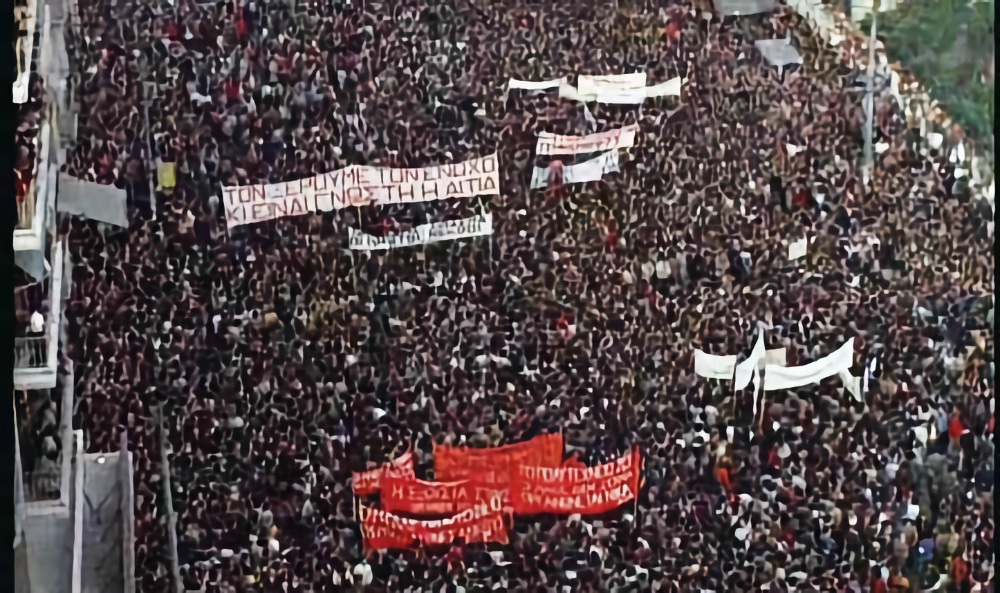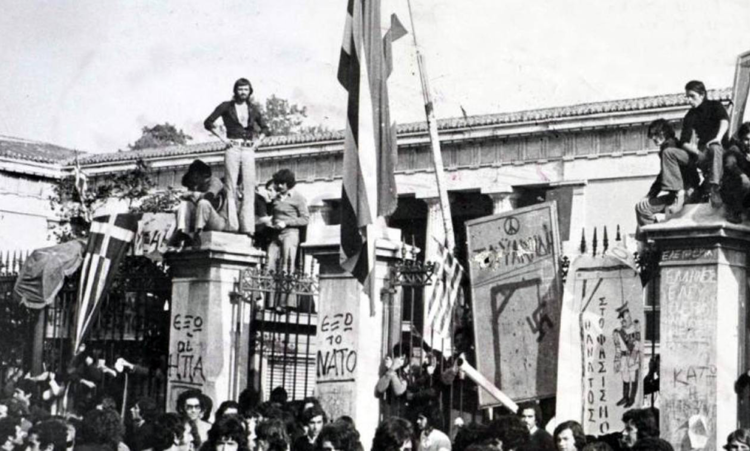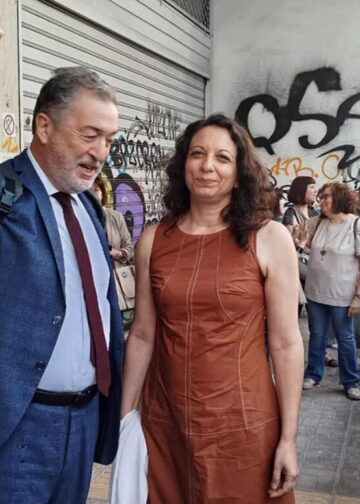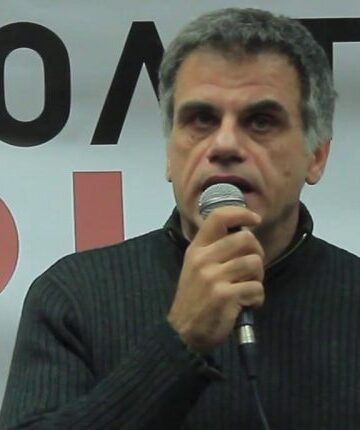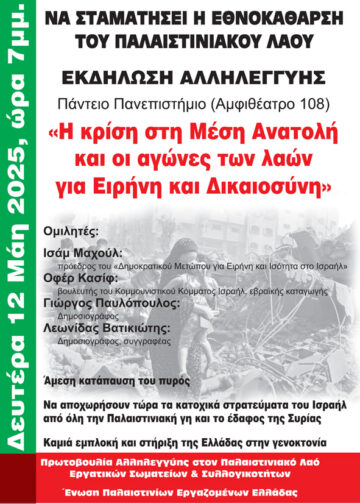The military regime of the 21st of April of 1967 in Greece was a fascist dictatorship of the domestic and foreign capitalists. The reactionary military circles of the country, which were closely connected to the secret services of the USA and NATO, conducted a military coup on 21st of April of 1967. Colonels who were actively involved in the coup, participated also in the collaborator security forces worked with the Nazi Occupation and the British-American forces fighting the communists during the Civil War (1944-1949).
The Civil War had left in place a regime democratic in name only. At its core was an army and monarchy that claimed to have refounded the nation by crushing the Left. Since the early 1960s Greek capitalism entered its phase of rapid development. The rates of capitalist accumulation were among the highest in the world. Despite the fact that capitalist accumulation has been strengthened in the 1960s, poverty and impoverishment of large sections of the population, not only in the countryside but also in the cities, still persisted. The post-civil war state had outlawed workers’ parties and organizations. The US military and secret services had backed the Greek regime as a bulwark against Communism. They began to fear it was becoming too brittle to survive an explosion from below.
A “royal coup” came on 15 July 1965 when a centrist Prime Minister was forced to resign by the King. The following weeks workers and students revolted calling for an end to the monarchy. For months people only went to their houses to rest—they had made the streets their home. One government fell on the 20 August, another on 22 September. Three more would go over the next two years. No government could satisfy the movement on the streets.
Centre Union party and the Democratic Left EDA (a front of the banned Communist Party KKE) wanted a constitutional monarchy that would allow them to form a government. CU and EDA made it clear that they did not raise a monarchy question and preferred a parliamentary political settlement. EDA, despite its’ high election results, up to 28%, not only failed to develop a true alternative, but even failed to prepare the party forces and the popular movement before the coup. If instead of paralyzing the movement EDA had embraced the demand to expel the king, it would probably have won it. That possibility frightened the king, the Army, the bourgeois and the USA. The inability of the Left to take a revolutionary perspective gave them time to organize their coup. Elections in May 1967 would have likely seen EDA enter the government. But right wing army officers seized power in a military coup on 21st April, ushering in seven years of dictatorship. The contradictions of the post-civil war state, instead of being resolved in favour of the workers, were finally resolved in a counter-revolutionary manner by the junta of the colonels.
Having seized the power, the military dictatorship in 1967 abolished every democratic liberty in the country. A marshal law had been imposed, strikes and meetings were banned, harsh censorship was introduced, political parties were also banned. By the order of the dictatorship, thousands of political and social fighters of our country were arrested.
“BREAD, EDUCATION, FREEDOM”
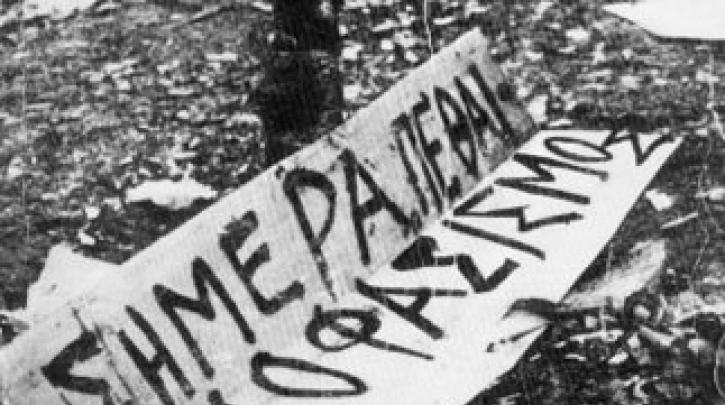
The sharpening of the socio-economic contradictions in Greece and the rise of the anti-dictatorship movement lead to the deep crisis of the regime. The struggle of the university students was an important parameter of the political developments in Greece, especially in 1973. Their main demands were the progressive reforms in the educational system, the restoration of trade union, academic and political liberties. The students of Athens, Thessalonica, Patras, conducted meetings, assemblies, demonstrations with slogans such as: “Democracy”, “Down with fascism”, “Down with the dictatorship”, “Freedom to the political prisoners”. Because of the worsening of the financial standing of the poor peasantry, mass manifestations started to break out through the whole of Greece, and took the form of refusal of handing the goods over to the trade. The solidarity with the political prisoners and their families’ movement, aiming at the release of the political prisoners, also developed.
In order to diminish the pressure towards the regime, the military dictatorship went on to form a “political” government. The main task of the new government was to prepare “parliamentary elections”. The political manoeuvres did not lead to the stabilization of the situation. The anti-government manifestations persisted. The uprising of the students of the Polytechnic University of Athens and of the young workers of Athens, on the 14-17 November 1973, gave the final blow to the attempts to disguise the regime.

The main slogan of the uprising were: “Bread, Education, Freedom”. Large masses of workers supported the students and the young workers. The students’ mobilizations acquired the form of university building occupations. In Athens, the students managed to create a radio station and inform people from the building of Polytechnic of the mass manifestations. During the second day of the occupation, thousands of people from Athens poured in to support the students. The demands of the occupation were anti-imperialistic and anti-NATO. Allied with the student protests were construction workers and some farmers who coincidentally protested on the same days in Athens. Students barricaded themselves inside the building of the Athens Polytechnic. In the early hours of November 17, the government sent a tank crashing through the gates of the Athens Polytechnic, imposing martial law. Dozens of people were killed by the army, police and snipers. As it became known after the fall of the dictatorship, 34.000 bullets had been used by the police, in addition to the 300.000 cartridges of all kinds, used by the army, so as to repress the revolt. In the days of the revolt, the regime went on to arrest 2.500 people.
Although the revolt had been drowned in blood, the overall reaction to the regime grew. Eight months later (24 July 1974), the dictatorship fell under the weight of its treason and adventurism in Cyprus, where a coup, that it had organized in cooperation with the secret services of NATO, led to the Turkish invasion and occupation of the 37% of Cyprus. The pressure of the masses had been so great that the Greek oligarchy, decided to remove junta and to hand the power over to a coalition of bourgeois parties, in which right-conservative elements persisted.
The revolt of the Polytechnic University was born from the subversive searches of many currents of the divided, persecuted Left. It surpassed its leaderships, which sought to find a “smooth” common ground to get rid of the military junta and to restore bourgeois democracy. There was a course of events that breached the limits of “what was possible” and created unity dynamics to overthrow the junta and exit from NATO, USA.
The flame of the Polytechnic Uprising is still burning!
The celebration of the anniversary of the Polytechnic and the march to the American Embassy every year is a point of reference for the struggling people, the students, the youth, the workers.
On April 21, 1975, hundreds of thousands of people took to the streets on the anniversary of the junta and marched all the way to the American embassy. There, students and members of the radical Left organizations stormed the embassy and managed to reach the ground floor.
The marches of the 17th November anniversary were forbidden the first years of bourgeois democracy. In 1980, the government had announced that it will not allow the demonstration to pass in front of the American embassy. Most of the student factions followed the specific modified route but members of the radical left-wing student factions did not obey and headed towards the embassy. However, police officers were waiting for them at the Parliament and assaulted the protest. 20-year-old worker Stamatina Kanellopoulou and 26-year-old Cypriot student Iakovos Koumis were killed by riot police.
The social-democratic government of PASOK legalized the anniversary, but in 1985 after a march of 150,000 people, a police officer shoots the 15-year-old student Michalis Kaltezas in the back of the head from a distance of just 20 meters, while he was running with other demonstrators.
Half a century later, the flame of the Polytechnic Uprising is still smoldering! It is not comfortable in the annals of official history. It brings back the questions of freedom and human emancipation and above all the revolutionary elaborations. It refuses those who want to turn it into a memorial reception. It continues, as a collective historical memory, to warm the consciousness of young people who are looking for ways to face the new, multiple aspects of social problems.
The youth uprising of the Polytechnic continues to have a decisive influence on the formation of the modern revolutionary current in our country. The bourgeoisie and its representatives are still afraid of the Polytechnic Uprising. That is why they take care to silence or distort it. In times like the present, with parliamentary totalitarianism and fascism showing its teeth again, the rulers go even further in seeking to downplay or discredit the Uprising. At the same time, bourgeois ideology likes to create the consciousness of a Polytechnic Uprising that can be integrated, in order to strengthen bourgeois democracy in the narrative of “national unity”.
The Polytechnic Uprising marches again in the streets towards the American Embassy and demonstrates against imperialism, the European Union and NATO. The new “Polytechnic Uprisings” will not look like the one in 1973. Not only in form, but especially in content and social composition. A new composition of young workers will emerge. In our time, the anti-imperialist democratic content of the Polytechnic is deepening, as an organic connection between the social-class question and the great issues of freedom and the possibility for the people to decide their own future. We are not waiting for the “new Polytechnics”, but we are consciously preparing the fields for them to explode.
